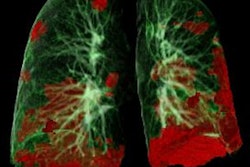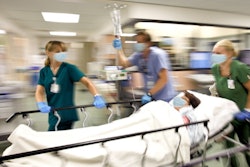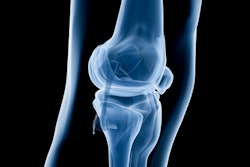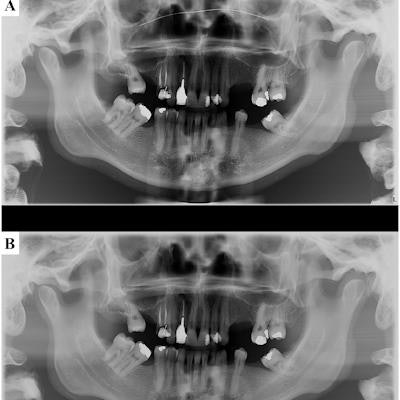
Is it possible to acquire extraoral images of patients while they are still wearing masks for protection against COVID-19? It's possible, if you take a few steps to counter artifacts that might develop, according to a letter published online September 19 in Academic Radiology.
A group led by Dr. Rocharles Fontenele of the University of Campinas in Sao Paulo described effective methods for obtaining extraoral x-ray and conebeam CT imaging of patients wearing masks during this time of low COVID-19 vaccination rates and emerging outbreaks due to SARS-CoV-2 variants, especially in developing countries.
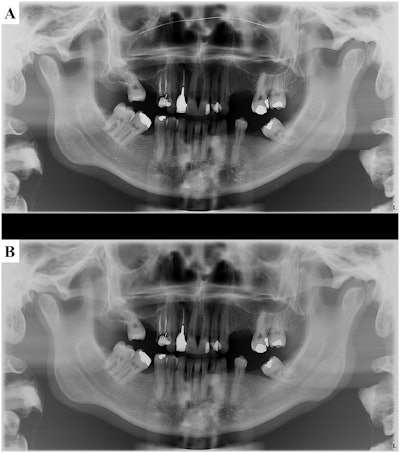 Panoramic radiographs of an anthropomorphic phantom covered with a soft-tissue simulator (Mix-D) acquired with the use of a face mask with a nose wire (A) and with the use of a face mask without nose wire (B). Image courtesy of Academic Radiology.
Panoramic radiographs of an anthropomorphic phantom covered with a soft-tissue simulator (Mix-D) acquired with the use of a face mask with a nose wire (A) and with the use of a face mask without nose wire (B). Image courtesy of Academic Radiology.They noted a few pitfalls to their technique, such as artifacts caused by nose wires in the masks, but they ultimately found the quality of imaging is unaffected when masks are worn.
"The use of a face mask without nose wire during extraoral imaging examinations may be considered a new infection control measure," the team wrote.
Oral radiology centers are considered high-risk environments for SARS-CoV-2 cross-contamination due to transmission through direct or indirect contact with oral secretions containing viral particles.
In January, North American and British oral and maxillofacial radiology specialists recommended a COVID-19 infection control strategy that includes the use of extraoral imaging in place of intraoral techniques whenever possible. In addition, the guidelines encourage the use of masks during exams in patients diagnosed with COVID-19 and those with suspected COVID-19.
The guideline should extend to all patients to prevent the spread of COVID-19, according to Fontenele and colleagues.
To that end, one factor to note is that most face masks include a nose wire. This can lead to the generation of metal artifacts that decrease image quality during conebeam CT. Simply remove the wire from the mask before image acquisition to avoid the superposition of its image on the nasal cavity and maxilla, the team suggested.
Imaging professionals should be aware that the effect of the nose wire may vary according to the thickness of the metal, the team wrote.
Importantly, the acquisition of extraoral examinations when patients are wearing face masks requires extra positioning adjustments. The bite block must be replaced with a chin rest to acquire extraoral images from edentulous patients.
"After positioning the patient's chin on the chin rest, the professional should instruct the patient to bite a disposable item such as a wood stick to promote disocclusion and avoid the overlap of the crowns of the upper and lower teeth," the team wrote.
Then, the midsagittal plane and the patient's canine prominence, which can be palpated without the need to remove the mask, must be aligned with the laser lights of the x-ray device, they instructed.
Lastly, it is essential to place protective barriers on surfaces that will be in contact with patients and properly disinfect them after exposure according to local protocols for infection control, the group wrote.
Many individuals infected with SARS-CoV-2 are asymptomatic or have mild symptoms similar to those of seasonal flu, the authors stated. Yet measures such as requiring all patients to wear masks during oral imaging procedures can prevent COVID-19 infections in professionals and patients, they concluded.






